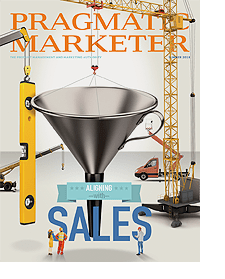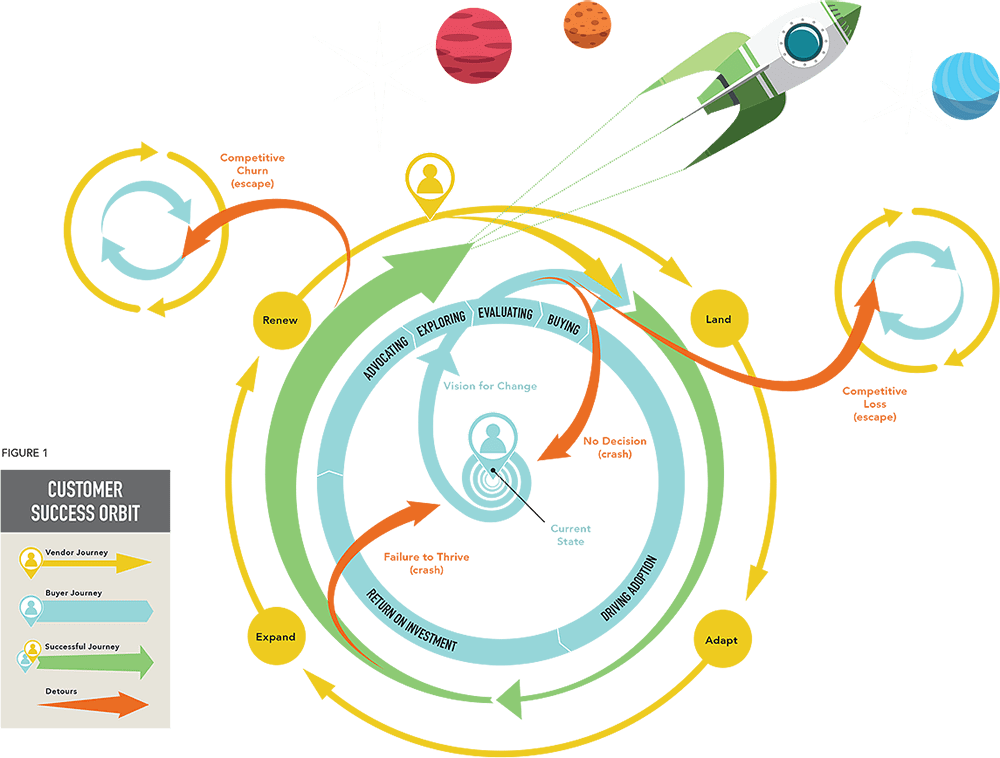
Customer churn is a big deal. Not only does it put the brakes on growth, but it is also expensive because it costs much more to acquire new customers than to retain existing ones. What’s more, in the new world of the subscription economy, customer retention is more critical than ever: An estimated 80 percent of a company’s future revenue depends on value derived after the purchase. Even companies with low churn rates recognize the importance of stemming the leaks and growing their customer base, not just continually working to acquire new customers.
The emergence of new SaaS, cloud, and subscription models has forced a full-scale reengineering of companies toward customer success that demands a more proactive, partnership-oriented approach to service delivery. Product marketers have always focused on customer acquisition. But in the subscription world, there needs to be a shift in thinking towards long-term customer success and redefining ideal buyer personas. It’s a shift that touches every team, from customer support and marketing to sales, product marketing, and product management.
If you simply rebrand your customer-support function as customer success, you will miss the boat. Retention and growth need the entire company’s attention and focus. As a veteran VP of customer success once told me: “Customer success can’t be the job of just one department; it has to be a central value of the company.” It’s vital that product management and marketing adjust to support this new reality of partnering with customers along their journey with a company, helping them find value and success in the products and services.
A New Model Is Needed
As Eigenworks worked with the CEO (let’s call her Jane), she shared her frustration about the intractable churn in her B2B SaaS enterprise. But in our experience, her company is not unique. My team has clocked thousands of hours interviewing, analyzing, and advising dozens of similar companies to help them understand buyer decisions and improve customer retention.
What has emerged is the need for a new model to describe the buyer’s journey in the subscription economy.
Virtually, every activity has a model: the sales funnel, the journey maps, the land and expand model. What’s missing in the subscription-economy world is a descriptive diagnostic tool that allows you to 1) see the buyer journey as a whole, 2) understand customer churn and retention, and 3) facilitate discussions about what’s going well and what needs to be fixed. This is our attempt to provide that conceptual model: the customer success orbit.
Pinpoint Where Things Go Wrong—and Right—in the Buyer Journey
Our new customer success orbit brings together two concepts that are familiar to SaaS companies. The land/expand model coined by TSIA is the foundation for the customer success orbit; it is also the foundation for the vendor’s journey (yellow path, Figure 1). The idea is to gain a foothold in a client company and expand it for growth, rather than trying to bite off a big chunk of business at the start. There are four phases: land, adopt, expand and renew.
Every vendor we work with talks about land/expand; its great value lies in recognizing that the sale is only the starting point. But it is named after—and focuses on—your goals as a vendor. My question for each client focused on land and expand is: Where is the buyer in this model?
Because we study buyers, it was natural for us to map the buyer’s journey (blue path, Figure 1) against land and expand. In the buyer’s journey, the buyer is at the center of this universe, stuck in the orbit of their current state until they develop a vision for change.
When the buyer develops a vision for change, things start to happen. Typically, an internal champion will lead the push for a new and better state. They will begin to explore the market to investigate solutions. If the champion is effective, and there is enough dissatisfaction with the current state, the buyer will achieve escape velocity from their old orbit. If they approach your sales function, they will have entered your orbit.
If you are successful in landing this new customer, you will begin orbiting together on a successful journey (green path, Figure 1). This is the place where the buyer’s journey—the blue path representing the buyer’s needs, motivations, and vision for change—meets and aligns with the vendor’s yellow journey of land, adopt, expand and renew.
However, not every buyer journey is a successful one. Detours and pitfalls (depicted in orange, Figure 1) exist in the land phase. Customers can crash back into their prior, painful state, or escape your orbit and fly off into a competitor’s orbit.
Of course, a crash or escape may also happen in the expand or renewal phases. This is the challenge of customer churn. So why does churn happen? What makes some customers successful while others crash or escape? And most important, how can we encourage more growth and less attrition?
Why Customers Crash or Escape
Customers crash (return to their prior state) or escape to a competitor for any number of reasons. Sometimes it’s a failure to execute on your part—similar to an athlete committing an unforced error. Other times—for reasons that may be beyond your control—the customer is simply unable to realize the value of your solution. The reasons may include:
- Failure to deliver on the original need
- Failure to provide needed organizational support to the buyer
- A difficult onboarding process
- An overly complicated product
- Customer’s inability to adopt or thrive
- A shift in customer needs; the solution no longer fits
- Customer funding was pulled and the initiative died
- The customer bought for an incorrect or irrelevant problem
Our customer success orbit model combines elements along the entire journey, allowing you to plot your situation. Where are customers crashing? Where are they escaping? What questions should you ask to determine why it is happening? For customers that stay on the success path, what factors are keeping them happy?
The three paths (success, crash, and escape) are the key diagnostic element of this model. By identifying where your customers are leaving an orbit, you can focus your efforts on the most critical points in the customer journey and diagnose things like:
- Where churn originates. If customers leave when it’s renewal time, you may want to look at whether the seeds for their escape were planted earlier in the cycle. If poor service or communication left the customer with a less than optimal product or service, dissatisfaction may have entered at onboarding. Or, things may have fallen apart farther down the line. For example, did the customer’s needs change and you were unable to anticipate and respond to those changes?
- What successful customers have in common. In the subscription economy, the ideal customer is shifting from someone you acquire to someone you can renew and expand. Ask yourself: Who is your ideal long-term customer? What are their characteristics and traits? Are there predictive patterns that can guide your sales team in targeting and acquiring the customers with the greatest potential lifetime value?
- How to identify the customers to avoid. It is important to understand the characteristics of customers who are unlikely to succeed with you. However, it can be hard to accept that you and a customer are not suited for one another (no one wants to say goodbye to a customer and the revenue they represent). But there may be times when it’s not a good fit, especially as you consider the requirements to ensure a successful experience through renewal and beyond.
- What you are doing that delights customers. It’s not all about crashing or escaping. Many customers travel along the green path of success, where their needs and goals meet your own. What can you do more of to guarantee they remain in your orbit?
Armed with this pattern of awareness, you can focus your resources on the places where you’ll create the greatest impact. You may not have the resources to address one-off pain points, but you can target the pattern. You can also double down on the things you’re good at to make more customers happy. And you can focus sales efforts on acquiring those customers who have the best chance of succeeding.
How Can This Model Help Product Marketing and Product Management?
The customer success orbit has broad applicability. It provides a framework for conversations about the buyer’s journey and offers a useful shorthand to pinpoint and describe what works and what doesn’t. When you want to fix a problem, the first step is to achieve alignment among your teams. Get everyone to agree, as much as possible, on defining the challenge you face. With this model, you can zero in on areas of problem and opportunity to facilitate alignment and decision-making. Once aligned, your teams can move quickly to pick the low-hanging fruit, and you can focus experiments on critical steps in the buyer journey.
With the help of Eigenworks, Jane, the CEO, was able to narrow down issues in each of these areas. In particular, we found one fairly simple health indicator that her company had not been monitoring, and we created customer success motions to ensure that every customer had implemented key product features. Now Jane’s product, customer success, and sales teams have initiatives aimed at addressing the barriers and capturing the opportunity uncovered in our investigation.
Product Management in the 21st Century
Today, more than ever, tech-enabled companies need product managers and product marketers to think across functions and teams as optimizers of product revenue. However, revenue only comes to those who make their customers successful, and in a world where everything is a service, you can no longer afford to look only at optimizing customer acquisition. You need to be keenly tuned in to the outcomes that customers need and ensure that at every step of their journey you are facilitating the next step. The customer success orbit is designed to help teams address these issues, focus discussions, pinpoint issues more easily, and move to action in a more aligned way.
Author
-
Alan Armstrong was founder and CEO of Eigenworks. See a LinkedIn tribute to Alan.









